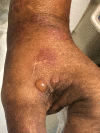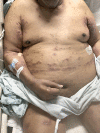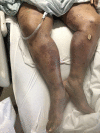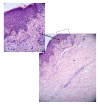Bullous Pemphigoid with Atypical Skin Lesions and Acute Interstitial Nephritis: A Case Report and Focused Literature Review
- PMID: 30773528
- PMCID: PMC6388647
- DOI: 10.12659/AJCR.911422
Bullous Pemphigoid with Atypical Skin Lesions and Acute Interstitial Nephritis: A Case Report and Focused Literature Review
Abstract
BACKGROUND The hallmark of bullous pemphigoid (BP) is widespread tense blisters arising on normal or erythematous skin, often with marked pruritus, the diagnosis of which is confirmed by direct immunofluorescence (DIF). BP is an autoimmune process that can be induced, though rarely, by medications. Drug-induced BP often has atypical clinical presentation, which requires a good understanding of other dermatological conditions with similar presentations, in particular, bullous subtype of erythema multiforme. End organ involvement warrants differentiating it from one of the severe cutaneous adverse reaction (SCAR) syndromes. CASE REPORT A 76-year-old African American male presented with extensive targetoid purplish skin lesions that clinically resembled atypical erythema multiforme, and one tense blister that raised a concern for BP. The patient presented 6 weeks after treatment with cephalexin for a urinary tract infection. Initial workup showed serum eosinophilia, acute kidney injury and eosinophiluria requiring deliberations on SCAR syndromes. A skin biopsy at an intralesional location showed a negative DIF, however, a skin biopsy at a perilesional site showed a positive DIF, confirming the diagnosis of BP. CONCLUSIONS This case demonstrates an atypical presentation of BP induced by drugs. It emphasizes the need for a greater level of awareness of diagnosis and treatment of the various entities that fall under adverse drug reactions in the elderly. It also highlights the need for appropriate choice of skin biopsy techniques (intralesional versus perilesional) to avoid misdiagnosis, as well as lessons on how to approach dermatologic conditions with end organ involvement for hospitalists and other medical professionals who routinely deal with undifferentiated disease conditions.
Conflict of interest statement
None.
Figures





References
-
- Walsh SR, Hogg D, Mydlarski PR. Bullous pemphigoid: From bench to bedside. Drugs. 2005;65(7):905–26. - PubMed
-
- Iwata H, Ujiie H. Complement-independent blistering mechanisms in bullous pemphigoid. Exp Dermatol. 2017;26(12):1235–39. - PubMed
-
- O’Riordan M, Dahinden A, Akturk Z, et al. Dealing with uncertainty in general practice: An essential skill for the general practitioner. Qual Prim Care. 2011;19(3):175–81. - PubMed
-
- Montgomery ND, Dunphy CH, Mooberry M, et al. Diagnostic complexities of eosinophilia. Arch Pathol Lab Med. 2013;137(2):259–69. - PubMed
-
- Long H, Zhang G, Wang L, Lu Q. Eosinophilic skin diseases: A comprehensive review. Clin Rev Allergy Immunol. 2016;50(2):189–213. - PubMed
Publication types
MeSH terms
Substances
LinkOut - more resources
Full Text Sources
Medical

